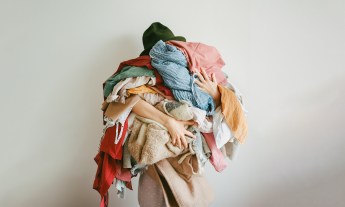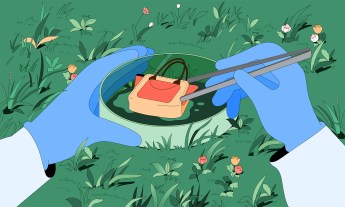
Most of us know that the fashion industry is built on an unsustainable business model powered by overconsumption. Clothing is cheaper than ever, brands release new styles every day and we can get a new wardrobe delivered to our door with the touch of a button.
In fact, between 2000 to 2014, annual clothing production doubled and the number of garments purchased per capita rose 60 percent. But this convenience comes at a high cost.
The fashion industry contributes to around 10 percent of global greenhouse gas emissions — which is more than the aviation and shipping industries combined. It’s also draining precious environmental resources: The industry produces about 20 percent of global wastewater and, what’s even worse, 85 percent of textiles end up in landfills or are incinerated.
The industry is clearly in need of large-scale change, so trying to make a difference with your individual purchases can feel discouraging. But through their everyday buying decisions, consumers can send powerful messages to big corporations and create demand for more sustainable products. If you’re looking to cut down on waste in an already wasteful industry, here are six ways to start:
Choose lower-impact materials
Cotton and polyester — two materials with a high environmental impact — dominate the fast fashion industry. Cotton production relies on pesticides and fertilizers that generate nitrous oxide (N2O), a greenhouse gas with more warming potential than methane and carbon dioxide. It also requires large amounts of water. In fact, a single cotton T-shirt can take up to 2,700 liters (713 gallons) of water to produce.
Meanwhile, polyester has a massive carbon footprint. “Polyester production for textiles released about 706 billion kilograms (1.5 trillion pounds) of greenhouse gases in 2015, the equivalent of 185 coal-fired power plants’ annual emissions,” according to the World Resources Institute. On top of that, polyester generates microplastics (tiny pieces of plastic that pollute the environment) every time you wash it. An estimated half a million tonnes of these microfibers end up in our oceans each year.
Instead of cotton and polyester, choose lower-impact natural materials, including wool, linen and lyocell (which is made from wood pulp).
Buy less and mend more
Fashion production is projected to rise 81 percent by 2030, according to the 2019 Pulse of the Fashion Industry report, and the only way to move the needle there is to change the model of overconsumption. For the members of climate activist network Extinction Rebellion, which urged people to boycott the fashion industry last year, that can mean buying no new items. For others, it might be as simple as investing in pieces you’ll wear for years and staying away from any trend-focused purchases. It can also mean mending and repurposing your already-used items to make them last longer. If you’re not handy with a needle and thread, it’s your chance to support a local tailor.
Purchase secondhand and vintage
If you still want to add the occasional item to your wardrobe, buying secondhand and vintage can reduce a garment’s carbon footprint by around 82 percent. Thanks to online resellers like Depop, ThredUp and The RealReal, buying used is an increasingly popular and convenient choice. In 2019, secondhand clothing expanded 21 times faster than conventional apparel.
“I don’t buy anything new. I get all my clothes secondhand from flea markets and thrift stores,” said designer Jessi Arrington in a TED Talk. “Secondhand shopping allows me to reduce the impact my wardrobe has on the environment and on my wallet. I get to meet all kinds of great people; my dollars usually go to a good cause; I look pretty unique; and it makes shopping like my own personal treasure hunt.”
There are also fashion rental options like Rent the Runway and Armoire that give you access to special occasion dresses or monthly subscription boxes of designer pieces. While renting can be a great way to wear trendy clothing with less impact, using their in-person drop-off and pickup locations, like Rent the Runway’s swap shops, can combat the environmental cost of packaging, shipping and returning items.
Look into brands’ labor practices
Fashion manufacturers often employ cheap labor to reduce production costs, relying on some 40 million low-wage garment workers in countries across Southeast Asia and Europe, the majority of whom are women.
Many are forced to work long hours in unsafe environments. For example, in 2013, an eight-story building housing several garment factories collapsed in Bangladesh — the second largest clothing manufacturer in the world. More than 1,000 workers died and over 2,500 were injured. Likewise, leather tannery workers are at higher risk of skin and respiratory diseases as a result of repeated exposure to hazardous chemicals without proper safety equipment. Because of huge power imbalances, these workers virtually have no recourse when it comes to negotiating salaries, hours or safety conditions.
Check brand websites to see if they publicly list their supply chain information, or search for it on sites like Fashion Checker. You might also consider reaching out on social media to ask about their labor practices. Not only could this start a conversation, it can also signal to the brand that consumers want supply-chain transparency.
Support Indigenous businesses
Indigenous people comprise less than 5 percent of the world’s population but protect 80 percent of global biodiversity, according to environmental activist Hindou Oumarou Ibrahim. So it’s no surprise that Indigenous design is rooted in sustainability, and using your purchasing power to support Indigenous-owned businesses can elevate the same communities who safeguard these resources.
“Many Indigenous people still carry the knowledge of living in harmony with nature, which is key for our world tackling climate change right now,” says womenswear designer Angel Chang. “However, this knowledge lies with the elders whose wisdom is quickly disappearing. Consumers can support Indigenous artisans by purchasing items that are made in the traditional way, according to the cycles of nature following techniques passed down from their ancestors.”
Champion new scientific technology
Scientists across the world are working on innovative ways to address fashion’s waste problem. Spain’s Ecoalf is creating shoes from algae and recycled plastic. The Amsterdam-based brand GumDrop collects gum and turns it into a new kind of rubber. Other companies are exploring biofabrication methods like “growing” clothes from microbes and producing leather from tissue cells without harming animals.
Natsai Audrey Chieza, the founder and creative director of Faber Futures, says that she believes customers need to demand more than just the technological intervention, and start asking what kind of values drive tech companies.
“We also know that the environmental crises we face cannot be solved with drop-in replacement technologies alone, because this market logic ignores difference, creates monopolies and reinforces dominant power structures, many of which have directly caused and sustained our environmental and social crises,” Chieza says. “Led by a strong desire to transition from a world built on historic and ongoing exploitative models to a more just future, citizens will signal a preference for products from companies built from the ground up to protect both people and planet.”
Watch Natsai Audrey Chieza’s TED@BCG Talk:
Watch Angel Chang’s TED-Ed Lesson and learn how sustainable sneakers really are:











